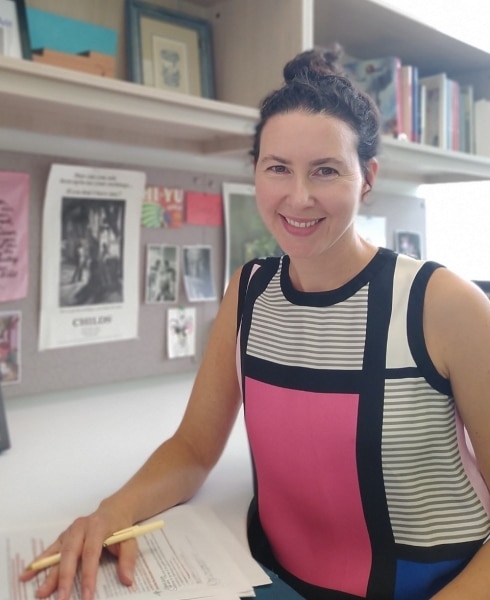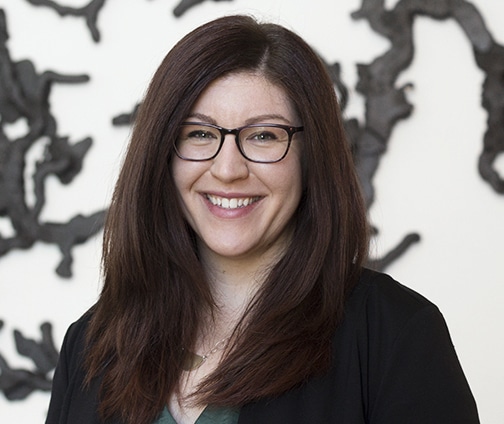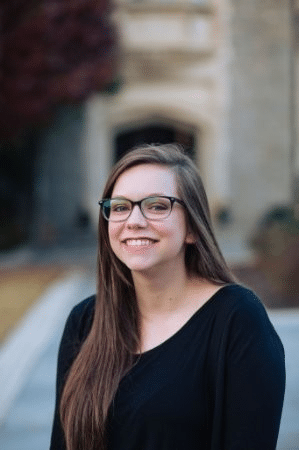Collecting, Curating, and Consuming American Popular Graphic Arts Yesterday and Today
Panelists
Robyn Asleson, National Portrait Gallery, Smithsonian Institution
Robyn Asleson is Curator of the Prints and Drawings Department at the National Portrait Gallery, Smithsonian Institution. Her exhibitions and publications often explore transnational aspects of art, the relationship of the visual and performing arts, and women as cultural agents. Her current exhibition projects include Brilliant Exiles: American Women in Paris, 1900-1939 (2024), Staging America: Theater and the New Nation (2025), and the team-curated Portraiture Now: Kinship (2022). She also curated the international series Portraits of the World, which featured one significant portrait on loan from another country each year, placed in conversation with works from the Portrait Gallery collection. Her past exhibitions and publications have focused on 18th-century British theatrical portraiture; the Aesthetic Movement; and the impact of classical antiquity on Victorian culture. Before joining the Portrait Gallery, Asleson held positions at the National Gallery of Art and the Huntington Library, Art Collections, and Botanical Gardens. She holds B.A., M.A., and Ph.D. degrees from Yale University.
Paper Overview
Re-presenting the Civil War and Reconstruction Eras through Popular Forms of Portraiture
In July 2022, the National Portrait Gallery will debut two new permanent collection galleries dedicated to the Civil War and Reconstruction periods. The new galleries will replace an installation created in 2006 that was dominated by large-scale, gilt-framed paintings and marble sculptures representing Union and Confederate military commanders. The new galleries will adopt a more comprehensive and less hagiographic approach to the past, featuring a wider range of people, represented in a variety of artistic media.
Although the display will continue to be anchored by paintings and sculptures, numerous examples of popular forms of portraiture (such as illustrated magazines, political cartoons, and mass-produced lithographs) will be fully integrated to provide the vital historical context that is deliberately excluded from formal portraits. The rich visual content of popular graphics will allow us to show the past rather than rely exclusively on labels to tell its story. In addition, by pairing popular prints with their source images, such as cartes de visite, the display will call attention to the underlying intent of printmakers’ constructions and speak to the capacity of visual culture to shape popular opinion and political will. The short display times required for works on paper provide opportunities for each rotation of objects to focus on a specific theme, allowing for deep dives into the past.
Anne Cross, University of Delaware
Anne Cross is a Ph.D. candidate at the University of Delaware; her dissertation, currently in progress, examines the publication of photographic images of atrocity in the Civil War mass press, focusing in particular on Harper’s Weekly. Her work has appeared in Panorama, the journal of the Association of Historians of American Art, and she has recently published an article in History of Photography.
Anne’s work has been supported by the Center for Advanced Study in the Visual Arts (CASVA), the Center for Material Culture Studies at the University of Delaware, the Joan and Stanford Alexander Foundation, and the American Council of Learned Societies. Anne was a 2020 Last Fellow at the American Antiquarian Society, and more recently, she was awarded a Suzanne and Caleb Loring Fellowship on the Civil War, Its Origins, and Consequences, as supported by the Boston Athenaeum and the Massachusetts Historical Society.
Anne received her Master’s degree in 2013 from the Institute of Fine Arts at New York University, and her Bachelor’s degree from New York University’s Gallatin School of Individualized Study in 2009. Prior to attending the University of Delaware, she served as the Luce Fellow in American Prints at the Philadelphia Museum of Art. Currently, she is the Lynn Herrick Sharp Curatorial Fellow at the Delaware Art Museum.
Paper Overview
“Illustrations of Chivalry”: Collecting and Curating Photographs of Atrocity in Philadelphia and Beyond
On June 18, 1864, Harper’s Weekly published two gruesome images that were intended to demonstrate the need for a victory over the South. Featured prominently on the issue’s cover, the illustrations represent two Union soldiers shortly after their release from Confederate prisons. In these images, the effects of their imprisonment are painfully rendered by the wood engraving process, as sharply incised lines articulate the angularity of their emaciated limbs. Significantly, Harper’s caption identifies the images as made after photographs taken in the U.S. General Hospital in Annapolis, Maryland. The images, in fact, are part of a larger series of photographs taken following the release of Union soldiers from Confederate prisons in the spring of 1864. Produced as cartes de visite, these horrifying photographs were circulated, collected, copied, and displayed across the North as part of a political campaign against the South amidst the 1864 presidential election. Copies of the Annapolis photographs were later marketed and sold by two Philadelphia studios: McAllister & Brother and Wenderoth & Taylor. The Library Company’s Graphic Arts Collection includes three Wenderoth & Taylor images under the ironic title “Illustrations of Chivalry.”
These images show men in states of extreme exposure and vulnerability. They were presumably taken without the subjects’ full consent and were copied and circulated for public consumption. This intention runs counter to our contemporary notions of privacy and medical ethics. What is evident, however, is that there was a public interest in, and market for, such images of suffering bodies both during the Civil War and today. In this paper, I consider not only the ethics of Harper’s publication of these images, but also the collecting of these images by individuals during the Civil War and by institutions today. In my analysis, I ask: How can we tell stories of violence without committing further violence? What steps can we take to extend care to our subjects and audiences in presenting challenging and/or disturbing images, including images of injured and suffering bodies? These questions take on particular resonance in our current moment, as the Black Lives Matter movement has reignited conversations around the circulation of images of Black suffering and traumatic death as a result of police violence.
D.B. Dowd, Sam Fox School of Design & Visual Arts, Washington University in St. Louis and Washington University Libraries
D.B. Dowd writes, lectures and curates exhibitions on the history of illustration and cartooning. He serves as Professor of Art & American Culture Studies at the Sam Fox School of Design & Visual Arts at Washington University (WU), where he teaches in the MFA in illustration and visual culture degree program and the undergraduate communication design major. He also serves as the Faculty Director of the D.B. Dowd Modern Graphic History Library at WU, renamed in his honor in 2016. The Dowd Library collects materials associated with 19th and 20th-century illustration and comics. His book A is for Autocrat: A Trumpian Alphabet, Illustrated (Spartan Holiday Books, 2020) won a national gold Addy award from the American Advertising Federation in 2021. Dowd’s book Stick Figures: Drawing as a Human Practice was published in 2018 by Spartan Holiday Books in association with the Rockwell Center for American Visual Studies. His recent essays include an assessment of Rockwell’s Four Freedoms for Enduring Freedom, the Norman Rockwell Museum’s traveling exhibition (2018) and “Nostalgia Illustrated: N.C. Wyeth, Advertising, and American Cultural History” for the Brandywine Museum retrospective, N.C. Wyeth: New Perspectives (2019). The third issue of Spartan Holiday, Dowd’s illustrated travel journal, appeared in 2019. Illustrations from Spartan Holiday have been juried into American Illustration and Society of Illustrators annuals. Dowd served as project leader for the Society of Fellows at the Norman Rockwell Museum in Stockbridge, Massachusetts, 2017-19. He earned a B.A. in history from Kenyon College in 1983, and an M.F.A. in Printmaking from the University of Nebraska-Lincoln in 1989.
Paper Overview
Beyond the History of Illustration: Excavating Complexity and Complicity in American Periodicals
In 1999, the Special Collections Department at Washington University Libraries was approached about receiving a donation of original artwork, process materials, and business records from the estate of Alfred Charles Parker (1906-1985), a celebrated illustrator associated with mid-century women’s magazines. The Library accepted the donation with support of design faculty in the Sam Fox School of Design & Visual Arts.
Soon the Libraries were fielding inquiries from other illustrators’ estates, and more collections arrived. In 2007, a unit was created to house the material, and a curator hired to steward it. Today the D.B. Dowd Modern Graphic History Library—endowed and named for a faculty member in 2016—houses many collections, including materials from leading illustrators from 1900. Holdings also include comprehensive collections like the Walt Reed Illustration Archive.
These collections can be used to shape narratives of professional influence in the field of illustration, a discourse of “significance” often associated with art history. But that may be the least useful way to look at illustrated magazines, an important cultural form from 1890 to 1960. Illustrators participated in a complicated editorial system. It took many workers’ efforts to produce a single issue of (say) Collier’s Weekly. Bursting with editorial content and plentiful advertising, “the slicks” and “pulps” reveal fault lines in American social history. When actively engaged, they retain the capacity to do cultural work today.
Recognizing a growing interest in vernacular forms of culture, in 2019 the Sam Fox School in partnership with University Libraries launched a distinctive MFA program in Illustration and Visual Culture (MFA-IVC), which combines writing, illustration/cartoon history, and hands-on work in the collections with studio practice in illustration.
The presentation will explore how program faculty work to complicate and enrich encounters with illustrated ephemera in a diverse graduate student population.
Shana Klein, Kent State University
Shana Klein is a professor at Kent State University and holds a Ph.D. in Art History from the University of New Mexico. There, she completed the dissertation—and now book—The Fruits of Empire: Art, Food, and the Politics of Race in the Age of American Expansion. This book demonstrates how pictures of food were not mere decoration, but a platform for artists and viewers to discuss heated debates over race and citizenship. Klein has been awarded several fellowships for her research at the Smithsonian American Art Museum and Georgia O’Keeffe Museum, among others. She has presented her research in a number of peer-review journals and podcasts and she teaches classes that bring together American art, material culture, and social justice.
Paper Overview
Cruel Intentions: Grappling with Racist Stereotypes in Trade-Card Advertisements of Food
In the late-19th century, the Boston Dental Association produced a trade-card advertisement that displayed a Black man’s face transformed into the green, waxy complexion of a watermelon. His caricatured smile mirrors the watermelon’s red interior and white rind that stretches across the width of the trade card. While the Boston Dental Association might have chosen this picture to advocate for the importance of dental care, the Association also used it to tap into a cruel and popular stereotype that claimed African Americans have an insatiable lust for watermelon. Historic depictions of Black people stealing, eating, and becoming watermelon perpetuated racist claims that African Americans were unfit citizens unable to control their behavior and appetite. Native American, Asian, and Dutch figures were stereotyped as well on food trade cards that suggested you are what you eat. In a time period of intense national expansion, accompanied by intense xenophobia shaping immigration and citizenship policies, food advertisements displayed anxieties about the racial makeup of the country. This presentation will analyze the strengths and limits of studying food artifacts and how we might thoughtfully collect, curate, and consume them in ways that expose and combat their cruel intentions.
Constance McPhee, Metropolitan Museum of Art
Connie is a curator in the Department of Drawings and Prints at the Metropolitan Museum, responsible for British drawings and prints, and American prints, before 1900. She joined the Met in 2000 as Study Room supervisor and assumed her current position in 2005. Exhibitions curated include Samuel Palmer, 1805–1881: Vision and Landscape in 2006, Infinite Jest: Caricature and Satire from Leonardo to Levine in 2011, and The Pre-Raphaelite Legacy in 2016. Recently, she worked on Revolution, Resistance and Activism, (September 2021-January 2022), which places art created in response to the political protests of 2020 within an historical context. Connie received her B.A. from Princeton University and M.A. and her Ph.D. from the University of Pennsylvania. She has worked to build the department’s British drawings holdings, linked over 400 works in the collection to Shakespeare, catalogued over 3,000 prints and drawings by Thomas Rowlandson, and currently is exploring Thomas Nast’s wood engravings. In 2020, she helped to create the web feature “How is a Drawing Made?”
Paper Overview
Embodying the United States: How Thomas Nast Turned Uncle Sam into a National Symbol
Uncle Sam’s changing aspect in prints offers fascinating insights into American popular culture across two centuries. After 1865, the lanky goateed figure wearing a “Stars and Stripes” suit became a tool that allowed cartoonists and illustrators to either urge patriotism or to voice political criticism. Few viewers today realize how profoundly Uncle Sam’s image was shaped by the German-born, New York based cartoonist Thomas Nast. While no catalogue raisonné of Nast’s work exists, the significant holdings of the Metropolitan Museum of Art allow significant insights into this subject. The Department of Drawings and Prints holds proofs donated by Nast’s children of wood engravings published in Harper’s Weekly and other periodicals, together with supporting material that places Nast’s imaginative imagery within a larger cultural context. My talk will touch on how the broadminded collecting philosophy of the Print Department’s founding curators, William Ivins and A. Hyatt Mayor, led them to acquire popular prints that offer cultural insights distinctly different from “artistic” ones. Nast is a case in point and the way he took a shadowy figure found in Civil War era cartoons by Currier & Ives and gave him a recognizable and enduring visual identity demonstrates the artist’s particular genius. In the 1870s and 1880s, Nast used Uncle Sam to both praise and castigate presidents and politicians—presenting him as fallibly human in contrast to the idealized female form of Columbia. Prints made in response to the Black Lives Matter protests of 2020 will serve as a coda to demonstrate how Uncle Sam remains alive and well as a trope within popular art.
Stephanie Mannheim, Queens College
Stephanie Mannheim is a student at Queens College’s Graduate School of Library and Information Studies and a program manager at comiXology. Her research interests include the use of comics in academic libraries and archives, comics cataloging and metadata, and zine librarianship. She received her B.A. in sociology from Barnard College, where she worked as an archives assistant at the Barnard College Archives, and wrote her undergraduate thesis on the evolving views of comics within highbrow publications. Stephanie is also a cartoonist, and her work has been published by Birdcage Bottom Books
Paper Overview
Challenging and Maintaining Cultural Narratives through Comics Archives
Beginning with their development in the second half of the 20th century, comics archives have challenged dominant archival practices through collecting materials traditionally seen as lowbrow. Previously, the comics medium has been viewed as unworthy of archival collecting. Comics archives challenge this notion of academic unworthiness and the silences created by their ephemeral uses. At the same time, silences within comics archives create situations where the most marginalized members of comics communities are excluded from the medium’s historical narrative. This literature review focuses on the contradictory uses of comics archives as both sources that challenge a cultural hierarchy and sites that legitimize a comics canon that, in turn, maintains the medium’s own hierarchy. A historical survey looks at the work that nonprofessional, volunteer “fans-as-archivists” used in developing and maintaining comics collections outside traditional archival spaces. Next, this presentation focus on some of the critiques of comics archives in upholding dominant narratives and archival practices, with a particular look at canon and the archival silence. Through maintaining comics canons in collections and exhibitions, archivists add to a collective memory of the medium that often minimizes the contributions of marginalized comic creators. This presentation then examines comics archives that challenge dominant narratives within the medium through community archival practices that center the work of comics creators and fans. Using strategies from these case studies, comics archivists can critically examine their own collections and work to develop more equitable comics archives.
Christina Michelon, Boston Athenaeum
Christina Michelon is Assistant Curator of Art and Special Collections at the Boston Athenaeum. She specializes in 19th-century American visual and material culture and received her Ph.D. in Art History from the University of Minnesota. Prior to joining the Athenaeum, she completed an NEH Fellowship at the American Antiquarian Society and a Postdoctoral Fellowship at the Winterthur Museum, Garden & Library. Her research has also been supported by the Smithsonian Institution, Henry Luce Foundation and American Council of Learned Societies, Center for Craft, Creativity, and Design, and the Library Company of Philadelphia. Her work has appeared in the journals American Art, Common-place, J19, and Panorama. She is currently working on a book about “printcraft” (the creative reuse of printed material) and an exhibition about 19th-century images of ruins after urban fires.
Paper Overview
Cut & Paste: Printcraft in Graphic Arts Collections
This presentation will introduce and define the genre of “printcraft,” a practice that includes collage, decoupage, extra-illustration, and other techniques that repurpose mass images toward creative, decorative, or instructive ends. In spite of their varied techniques, subjects, and styles, printcrafts exist at the intersection of uniqueness and mass production, preservation and destruction, imitation, and ingenuity. During the 19th century, when image-making technologies evolved at unprecedented rates, the manipulation of print became a vehicle for asserting one’s agency and subjectivity with the materials at hand. Many 19th-century printcrafts were wrought by women and children, whose artistic production often remains marginalized and anonymous, relegated to categories of oddity or folk art, child’s play or women’s work.
Focusing especially on examples of printcraft in The Library Company’s collection, I will demonstrate how a sustained consideration of the genre can yield important insights into the role of graphic arts in shaping our surroundings and identities during the 19th century and beyond. For example, Making the Scrapbook (1865), printed by Louis Kurz after a painting by Juliana Oakley, serves as a representation of this craft impulse and the centrality of both print and creative engagement to the cultivation of ideal (often white) woman- and girlhood. This is borne out in the many scrapbooks housed at the Library Company and other institutions. The volumes are examples of printcraft that exhibit the acts of collecting, consuming, and curating mass images most explicitly. Meanwhile, the “Things Left in Books Box,” an unassumingly significant piece of Library Company history, self-referentially underscores the long and complicated relationship that cultural repositories have had with printcrafted objects. By directing our attention toward understudied modes of engagement with printed material, printcraft asks us to think about the longer histories of complex media environments and the creative ways we have been grappling with them for centuries.
Phillippa Pitts, Boston University
Phillippa Pitts is a Ph.D. candidate and Horowitz Foundation Fellow for American Art at Boston University. Her research questions social, political, and racial borders within American art of the 19th and early 20th century, highlighting the aspirations and anxieties around expansion, immigration, xenophobia, and indigeneity that underpin such constructions. Her dissertation, “Pharmaceopic Dreams: Art in America’s Medical Democracy, 1800-1860” employs a disability studies lens to explore antebellum artists’ engagement with intertwined rhetorics of health, nation, expansion, and self-reliance. Phillippa returned to doctoral work after almost a decade in museum interpretation and remains a passionate advocate for equity, inclusion, and accessibility in the arts. Her work has been generously supported by the Center for Advanced Study in the Visual Arts, the Kress Foundation, and the University of Michigan.
Paper Overview
Pharmaceutical Dreamworks: Rhetorics of Race, Gender, and Disability in American Drug Advertising, 1800 to Now
Pharmaceuticals are not simply cures to disease. From multivitamins and fish oil supplements to analgesics and cancer therapies, pharmaceuticals are nothing less than the hope for good health, bottled and sold as a commodity. While scientists describe and debate medications’ efficacy based on their chemical properties, such disease and remedy-oriented histories of medicine will invariably provide only limited access to the hopes, aspirations, imaginaries, and fears which surround pharmaceutical consumption. It is, in fact, in the popular arts where these dreamworks thrive.
While an untrained eye easily spots the racialized projections of dirt and disease in the infamous 1899 Pear’s Soap advertisement, not all pharmaceutical dreamworks are so transparent. This paper looks back to the 19th-century apex of America’s patent medicine industry when the contents of tonics and tinctures were not only unproven but rarely even disclosed to authorities, let alone buyers. Thus, the social—not scientific—arena shaped period understandings of medicines’ efficacy, as well as their physical, psychological, and societal effects. Providers leveraged popular desires and anxieties around expansion, immigration, miscegenation, and masculinity to negotiate their products’ positions within the unstable spectra of food to medicine, pharmaceutical to intoxicant, morality to licentiousness. These ideologies and rhetorics—from false corollaries between willpower and health to the erasure of Indigenous knowledge—persist in pharmaceutical imagery and imaginings today.
Thus, this paper makes a compelling case for the importance of drug advertisements and trade cards far beyond their peripheral status within art history. In doing so it asks, what does it mean to collect and catalog these objects? Who should study and learn from them? What unique insights can they offer into this country’s response to health, disease, and vulnerability, particularly in the midst of two concurrent national health emergencies: COVID-19 and systemic racism?
Larissa Randall, Crystal Bridges Museum of American Art
Larissa Randall (she/her/hers) is the curatorial associate for American Art at Crystal Bridges Museum of American Art in Bentonville, Arkansas. In her role, she focuses caring for the pre-1960 Early American, Native American, and Modern art collections. Randall is particularly interested in interdisciplinary curatorial projects that highlight objects across media and situate art museums as spaces for dialogue and social justice. Her research interests prioritize 18th- and 19th-century American prints. Randall draws upon her six years of curatorial experience to support the American art program at Crystal Bridges. She most recently served as the Sara Giles Moore Foundation Research Fellow for American Art at the High Museum of Art in Atlanta, Georgia after receiving her B.A. in Art History and Studio Art from Oglethorpe University.
Paper Overview
American Printmakers and the Politics of Printing the U.S. Flag
American identity is elusive and complex. The graphic identity of America has changed over time, yet today is rather straightforward: red, white, and blue; fifty white, five-pointed stars symmetrically arranged in sequential rows within a blue limit, barred by thirteen red and white stripes. The flag of the United States of America has been widely reproduced and circulated by lithographers and illustrators alike from the 18th century to today, providing a foundational symbol for European-American settlers to rally around, identify with, and sport while nation-building. I will argue that American graphic artists have historically mobilized images of the U.S. flag to point to underlying histories of violence in the United States. By reexamining the visual application and impact of the U.S. flag embedded in printed scenes of engaged citizenry, mass-produced art can reveal how the flag of the United States of America is not, nor has it ever been, a neutral symbol.
By drawing connections between 19th- and 20th-century book arts, hand-colored lithographs, and screen-prints, this paper further contextualizes popular American graphic artists, such as John Krimmel and Red Grooms, as inherently political and radical. For instance, visual analysis of Kimmel & Forester’s 1868 folio The Flags of the World, where the U.S. soldier is the only figure depicted with a weapon in addition to his flag, can inform our understanding of current events where the U.S. flag operates as a charged, divisive symbol—such as the insurrection of the United States Capitol on January 6, 2021. Furthermore, this paper examines renderings of the U.S. flag in printed scenes of engaged citizenry, reconciling the aesthetic and political value of individual printmakers while also pointing to the hard histories in which the art is entrenched.









